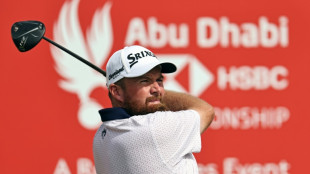
-
 Scandic Trust Group strengthens sales network with First Idea Consultant
Scandic Trust Group strengthens sales network with First Idea Consultant
-
Fleetwood and Lowry lift each other into Abu Dhabi lead

-
 Fleetwod and Lowry lift each other into Abu Dhabi lead
Fleetwod and Lowry lift each other into Abu Dhabi lead
-
New Zealand make changes after Barrett brothers' injuries as Scotland drop Van der Merwe

-
 Dallas Cowboys' Marshawn Kneeland dies at 24: franchise
Dallas Cowboys' Marshawn Kneeland dies at 24: franchise
-
Pegula dispatches Paolini to keep WTA Finals semis bid alive

-
 Dutch giants Ajax sack coach John Heitinga
Dutch giants Ajax sack coach John Heitinga
-
Kirchner on trial in Argentina's 'biggest ever' corruption case

-
 Amorim urges Man Utd to 'focus on future' after Ronaldo criticism
Amorim urges Man Utd to 'focus on future' after Ronaldo criticism
-
US judge drops criminal charges against Boeing over 737 MAX 8 crashes

-
 World must face 'moral failure' of missing 1.5C: UN chief to COP30
World must face 'moral failure' of missing 1.5C: UN chief to COP30
-
UK grandmother leaves Indonesia death row to return home

-
 Garcia broken nose adds to Barca defensive worries
Garcia broken nose adds to Barca defensive worries
-
Tight UK security ahead of match against Israeli club

-
 Ethiopia's Afar region says attacked by Tigray forces
Ethiopia's Afar region says attacked by Tigray forces
-
Nancy Pelosi, Democratic giant, Trump foe, first woman House speaker, to retire

-
 Israel strikes Hezbollah targets in Lebanon
Israel strikes Hezbollah targets in Lebanon
-
Burger strikes as South Africa restrict Pakistan to 269-9 in second ODI

-
 Stocks slip as investors weigh earnings, tariffs
Stocks slip as investors weigh earnings, tariffs
-
Police say 19 held after raid at Swedish start-up Stegra to be deported

-
 Kante returns as France seek to clinch World Cup berth
Kante returns as France seek to clinch World Cup berth
-
Marcus Smith starts at full-back as England ring changes for Fiji

-
 Kolisi 100th Test 'no distraction' for Erasmus' South Africa
Kolisi 100th Test 'no distraction' for Erasmus' South Africa
-
Teetering Belgian government given more time to agree budget

-
 Merz backs EU plan to protect steel sector from Chinese imports
Merz backs EU plan to protect steel sector from Chinese imports
-
New Zealand make Scotland changes after Barrett brothers' injuries

-
 'Roy of the Rovers story' -- Farrell handed Ireland debut for Japan Test
'Roy of the Rovers story' -- Farrell handed Ireland debut for Japan Test
-
Stones backs Man City team-mate Foden to pose England dilemma for Tuchel

-
 Djokovic to face Alcaraz in ATP Finals groups
Djokovic to face Alcaraz in ATP Finals groups
-
Facing climate 'overshoot', world heads into risky territory

-
 Springbok skipper Kolisi to play 100th Test against France
Springbok skipper Kolisi to play 100th Test against France
-
Typhoon Kalmaegi hits Vietnam after killing 140 in Philippines

-
 Bank of England leaves rate unchanged before UK budget
Bank of England leaves rate unchanged before UK budget
-
Germany recall Sane, hand El Mala debut for World Cup qualifers

-
 India thump Australia to take 2-1 lead in T20 series
India thump Australia to take 2-1 lead in T20 series
-
Cameroon's Biya, world's oldest president, sworn in for 8th term

-
 Flick holding firm on Barca high line despite defensive woes
Flick holding firm on Barca high line despite defensive woes
-
Battered US businesses eye improved China trade at Shanghai expo

-
 France opt for Le Garrec as Dupont replacement for 'best team ever' South Africa
France opt for Le Garrec as Dupont replacement for 'best team ever' South Africa
-
Drugmaker AstraZeneca profit jumps as US business grows

-
 'Vibe coding' named word of the year by Collins dictionary
'Vibe coding' named word of the year by Collins dictionary
-
Vietnam evacuates thousands from coast ahead of Typhoon Kalmaegi

-
 European stocks fall after gains in Asia, US
European stocks fall after gains in Asia, US
-
MotoGP legend Agostini admires Marc Marquez's 'desire to win'

-
 Nepal searches for avalanche victims
Nepal searches for avalanche victims
-
Hezbollah rejects any negotiations between Lebanon and Israel

-
 Chapman blitz leads Black Caps to tight T20 victory over West Indies
Chapman blitz leads Black Caps to tight T20 victory over West Indies
-
France urges EU to sanction Shein platform

-
 France opt for Le Garrec as Dupont replacement for South Africa Test
France opt for Le Garrec as Dupont replacement for South Africa Test
-
Turmoil in tiaras at Miss Universe pageant in Thailand


Spinal cord implant helps paralysed patients walk again
In 2017, Michel Roccati was in a motorbike accident that left his lower body completely paralysed. In 2020, he walked again, thanks to a breakthrough new spinal cord implant.
The implant sends electrical pulses to his muscles, mimicking the action of the brain, and could one day help people with severe spinal injuries stand, walk and exercise.
It builds on long-running research using electrical pulses to improve the quality of life for people with spinal cord injuries, including a 2018 study by the same team that helped people with partial lower-body paralysis walk again.
"It was a very emotional experience," Roccati told journalists of the first time the electrical pulses were activated and he took a step.
He was one of three patients involved in the study, published Monday in the journal Nature Medicine, all of them unable to move their lower bodies after accidents.
The three were able to take steps shortly after the six-centimetre implant was inserted and its pulses were fine-tuned.
"These electrodes were longer and larger than the ones we had previously implanted, and we could access more muscles thanks to this new technology," said Jocelyne Bloch, a neurosurgeon at the Lausanne University Hospital who helped lead the trial.
Those initial steps, while breathtaking for the researchers and their patients, were difficult and required support bars and significant upper body strength.
But the patients could start rehabilitation immediately, and within four months Roccati could walk with only a frame for balance.
"It's not that it's a miracle right away, not by far," cautioned Gregoire Courtine, a neuroscientist at the Swiss Federal Institute of Technology who led the research with Bloch.
But with practice, Roccati can now stand for several hours and walk nearly a kilometre. The Italian described being able to look clients in the eye, have a drink at a standing table and take a shower standing up thanks to the implant.
He and others in the trial were also able to climb stairs, swim and canoe.
- 'I see the improvement' -
The improvements depend on the electrical stimulation, which is triggered via a computer carried by the patient that activates a pattern of pulses.
Two of the patients can now activate their muscles slightly without electrical pulses, but only minimally.
By comparison, some patients with partial lower body paralysis treated in an earlier study are able to move their previously immobile legs and stand without stimulation.
The three men in the new trial were all injured at least a year before the implant and Bloch hopes to trial the technology sooner after an accident.
"What we all think is that if you try earlier it will have more effect," she said.
There are challenges: in early recovery, a patient's capacity is still in flux, making it hard to set a baseline from which to measure progress, and ongoing medical treatment and pain could hamper rehabilitation.
So far, the implants are also only suitable for those with an injury above the lower thoracic spinal cord, the section running from the base of the neck to the abdomen, because six centimetres of healthy spinal cord is needed.
The idea of using electrical pulses to address paralysis stemmed from technology used to regulate pain, and the researchers said they see scope for further applications.
They have also shown it can regulate low blood pressure in spinal cord injury patients and plan to soon release a study on its use for severe Parkinson's disease.
The team cautioned that significant work remains before the implant is available for treatment outside clinical studies, but said they receive around five messages a day from patients seeking help.
They next plan to miniaturise the computer controlling the pulses so it can be implanted in patients and controlled with a smartphone.
They expect this to be possible this year, and have plans for large-scale trials involving 50-100 patients in the United States and then Europe.
Roccati said he activates the implant daily at home and continues to get stronger.
"I see the improvement every day," he said.
"I feel better when I use it."
J.Williams--AMWN



